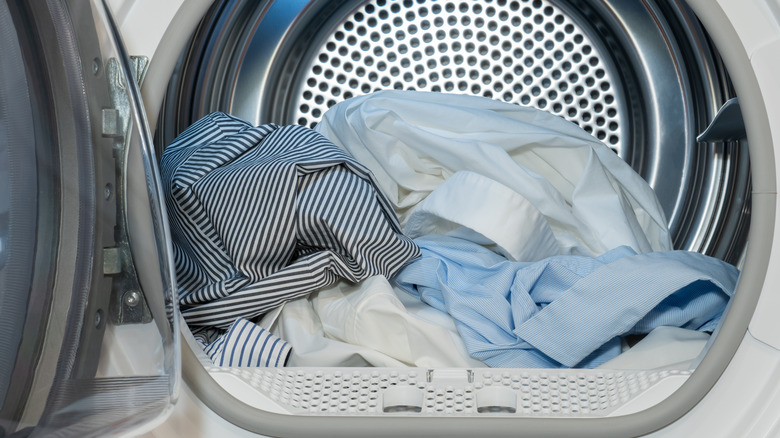How Does The Permanent Press Cycle Work In A Dryer?
Put wet laundry in. Take dry laundry out. What more could you want from a clothes dryer? Most busy homeowners are content when the appliance merely does what's expected without making a loud banging noise or forcing them to do mental math when the dryer's timer estimate doesn't tell the truth. So imagine your reaction if you knew your dryer could do more than simply extract moisture from damp items. Brace yourself: The permanent press cycle is here to serve. The feature is designed to maintain an optimal heat level to gently erase wrinkles and reduce shrinkage in an array of popular fabrics.
You may have ignored the permanent press cycle on your dryer, but are familiar with the term because you've seen it on clothing care labels as a symbol featuring a circle inside of a square with a single line underneath. The term "permanent press" was originally coined in the 1950s to denote fabrics treated with chemicals designed to reduce wrinkles. Shortly after, washer and dryer manufacturers adopted the maxim, and the appliance setting was born.
If you haven't had the time or the motivation to experiment with different settings on your dryer, you might want to make an exception when it comes to permanent press. Depending on the brand and model of your dryer, the permanent press cycle may be labeled "perm press," "casual," or "wrinkle control." Regardless, its function is to make life easier by eliminating the need to manually iron mountains of creased clothing.
Secrets of an underused wrinkle eraser
The magic behind a dryer's permanent press setting boils down to time and temperature. Rather than constantly frying your clothes at high heat for nearly an hour, permanent press combines high and low drying periods to create a medium heat — generally between 125 and 135 degrees Fahrenheit — for roughly 30 to 40 minutes. Compare that to the "regular" cycle where clothes are tumbled for about 10 minutes longer at temperatures 10 to 15 degrees hotter. This moderate heat forges the ideal conditions to relax fabrics, which helps prevent creases and crumpling.
Additionally, on most dryers, the permanent press setting also includes a cooldown period at the end of the cycle where warm air is replaced with room temperature air to protect against fading, shrinking, pilling, and excessive wear and tear of the materials' fibers. However, to maximize the positive effects of the permanent press setting, it helps to be proactive. Rather than stuffing your dryer like a clown car, give your clothes room to move freely by loosely placing only enough to fill the drum to no more than 75% of its capacity.
Moreover, don't procrastinate when it comes to retrieving your laundry at the end of the permanent press cycle. Garments left sitting at the bottom of the drum will likely sustain at least some wrinkling due to the weight of the items on top, thereby negating the benefits of the dryer's permanent press setting.
When to use the permanent press cycle
The permanent press dryer setting is best suited for synthetic fabrics, such as polyester, spandex, rayon, acrylic, nylon, and clothing categorized as "permanent press." Its status is typically denoted with labels that read: "wrinkle-free," "wash-and-wear," or "tumble dry." Just be careful to monitor "wrinkle-free" garments running in a permanent press load; it's best to remove these items from the dryer when they are slightly damp and allow them to air dry to keep them from creasing. In addition, the setting can safely dry laundry made of natural fibers, including cotton and linen, though avoid using the setting on fragile fabrics like silk, lace, and wool. Also, towels, jeans, bedding, and other heavy-duty items are not recommended for permanent press mode as they need a higher heat setting in order to thoroughly dry.
Finally, if you feel like a slave to your iron, forever erasing creases and grooves from khakis, dress shirts, and capris, make friends with the permanent press setting — even with dry clothes. You can use the cycle as a makeshift iron by placing light to moderately wrinkled clothing items straight from your drawer or closet in the dryer and running the garments on the permanent press setting for about 10 minutes. The warm air will help loosen lines and wrinkles from dry garments without the pain of having to haul out your iron and board.


